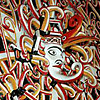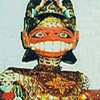



|
|
Unlike some countries art forms in Indonesia are not only based on folklore, as many were developed in the courts of former kingdoms such as in Bali, where they are part of religious ceremonies. The famous dance dramas of Java and Bali are derived from Hindu mythology and often feature fragments from the Ramayana and Mahabharata Hindu epics. Highly stylized in movement and costume, dances and the "wayang" drama are accompanied by a full "gamelan" orchestra comprising xylophones, drums, gongs, and in some cases string instruments and flutes. Bamboo xylophones are used in North Sulawesi and the bamboo "angklung" instruments of West Java are well- known for their unique tinkling notes which can be adapted to any melody. The "Wayang kulit" (leather puppets) of Java is performed with leather puppets held by the puppeteer, who narates the story of one of the famous episodes of the Hindu epics, the Mahabharata or the Ramayana. It is performed against a white screen while a lantern in the background casts the shadows of the characters on the screen, visible from the other side where the spectators are seated. The "Wayang Golek" (wooden puppets) of West Java is based on the same concept. The crafts of Indonesia vary in both medium and art form. As a whole the people are artistic by nature and express themselves on canvas, wood, metals, clay and stone. The batik process of waxing and dyeing originated in Java centuries ago and classic designs have been modified with modern trends in both pattern and technology. There are several centres of Batik in Java, the major ones being Yogyakarta, Surakarta, Pekalongan and Cirebon. Batik is also being produced in some other areas as in Bali where local designs are incorporated. Other provinces produce hand-woven cloths of gold and silver threads, silks or cottons with intricate designs. Painting are numerous all over the country, both traditional and contemporary, woodcarvings for ornamentation and furniture, silverwork and engraving form Yogyakarta and Sumatra, filgree from South Sulawesi and Bali with different styles of clay, sandstone and wood sculptures. These are but a few of the handicrafts found in Indonesia. |
 |
 |
 |
Copyright © 1999 Eastjava Tourism of Indonesia. All rights reserved,Term of Use, Webdesign by Baligraph Graphic House.


